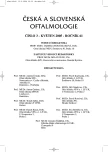Comparison of Accuracy of Refraction Measurement in Children up to the Age of 15 Years by Eccentric Phototrefraction and by Standard Techniques
Authors:
J. Ošmera 1; J. Korynta
Authors‘ workplace:
Oční klinika dětí a dospělých 2. LF UK, Praha
přednostka doc. MUDr. Dagmar Dotřelová, CSc.
1
Published in:
Čes. a slov. Oftal., 61, 2005, No. 3, p. 198-204
Overview
Objective:
To establish whether refraction state in children up to the age of 15 years measured by photorefraction using PowerRef II device is comparable with values measured using common methods like skiascopy and autorefractor.
Photorefraction is a quick method to determine refractive state from a distance without mydriasis and simultaneously in both eyes. It appears, therefore, to be a useful tool for measuring refractive errors of infants and older noncooperative subjects. However, its accuracy and reliability has been discussed.
Methods:
In this study the authors assess accuracy of measurement of refractive errors by photorefraction in 40 children (19 boys, 21 girls) at the age ranging from 4 month to 15 years (average 4.8 years), divided according to their cooperation into two groups. The values of refraction acquired by photorefraction using PowerRef II device were compared with skiascopy in 23 noncooperative infants and with values of refraction from common autorefractor Nidek AR 600 in 17 cooperating children.
Results:
Comparing results of both groups we have detected an average difference 0.41 D between skiascopy and photorefraction for spherical equivalents (0.45 for spheres, 0.42 for cylinders), average difference between spherical equivalents from autorefractor and photorefractor measurements was comparable: 0.52 D (0.51 for spheres, 0.55 for cylinders).
Conclusion:
Refractions measured by eccentric photorefraction with PowerRef II were comparable to those obtained by common methods of refraction measurement in children – i.e. skiascopy and autorefractor. Values of refraction were undervalued only in two cases of higher myopia during photorefraction measurement compared to autorefractor values. There was no significant shift by photorefraction measurement to myopic or hypermetropic values.
Key words:
photorefraction, PowerRef II, autorefractor, skiascopy
Labels
OphthalmologyArticle was published in
Czech and Slovak Ophthalmology

2005 Issue 3
Most read in this issue
- Terson’s Syndrome, Pars Plana Vitrectomy and Anatomical and Functional Outcome
- Congenital Stationary Night Blindness (CSNB) – a Case Report
- Spontaneous Late Subluxation of Capsule, Intraocular Lens and Capsular Ring in Patient with Pseudoexfoliation Syndrome – a Case Report
- Perforating Pars Plana Sclerotomy in Idiopathic Uveal Effusion Syndrome
